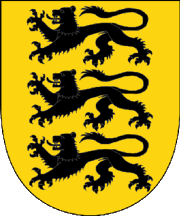![[Soviet Republic of Bavaria 4th April - 1st May 1919 (Germany)]](../images/d/de}ddred.gif) Image by Santiago Dotor
Image by Santiago Dotor
Last modified: 2021-01-23 by klaus-michael schneider
Keywords: germany | historical | bavaria | bayern | swabia | schwaben | bavarian soviet republic |
Links: FOTW homepage |
search |
disclaimer and copyright |
write us |
mirrors
![[Bayern lozengy civil and state Flag (Germany)]](../images/d/de-by2c.gif) 3:5
3:5 image by M. Schmöger, 2 Feb 2001
On this page:
image by M. Schmöger, 2 Feb 2001
On this page:
Most of the Bavarian historical flags' information is from Drake-Brockman 1983.
Norman Martin, August 1998
An official flag for Bavaria was adopted only in 1878. The lozenged flag was the flag of Wittelsbach family and it was used since 1337. From ca.1506 the white standard with the arms began to be used. Later a great number of different standards were used. Before 1878 all the flags were unofficial, based on the Landesfarben white and blue, the latter should had been light after a royal decision of 1838. The official flag for Bavaria was adopted by royal decree (11 September 1878) and it was white over light blue. King Louis II stated that all the flags, on land and at sea, were of two horizontal stripes.
Mario Fabretto, 3 August 1998
Bavaria (Bayern) was a Duchy until 1507, when it became an Electorate (Kurfürstentum Bayern). It became a kingdom in 1806 (Königreich Bayern), a republic in 1918 and a federal free state (Freistaat Bayern) shortly after that.
Santiago Dotor, 8 September 2000
From 4 April to 1 May 1919: plain red flag. After this the white-blue flag was restored.
Jaume Ollé, 24 August 1998
 Speculative Shield of the Duke of Swabia by Pete Loeser
Speculative Shield of the Duke of Swabia by Pete Loeser
The banner of the fictitious Duke Romulus of Swabia (Schwaben, around Augsburg in Bavaria), is shown in a manuscript dating from the late 15th Century. It was a Schwenkel, a long pennant attached to the top of the fly. The text in the manuscript can be translated as:
German vexillologist Gunnar Staack wrote this (my translation follows each paragraph):
At present there is only one official territorial division "Swabia" (Schwaben) and that is the Bavarian District of Swabia (Regierungsbezirk Schwaben). This has a district flag, granted 15th October 1965: "The flag has two stripes, red and yellow; it may also have the district coat-of-arms on it."...(Source: Der Flaggenkurier, no. 5, 1997.)
Upper Schwaben is at present the name of the southern region of Baden-Württemberg between the Danube and Lake Constance. There is no flag.
Die in der von Jarig Bakker gezeigten Flagge des Herzogs Romulus vorkommenden drei schwarzen Löwen auf goldenem Grund gibt es noch heute im Wappen Baden-Württembergs.
The three black lions on a golden field on the flag of Duke Romulus pointed at by Jarig Bakker are still present on the coat-of-arms of Baden-Württemberg.
Schwaben war im Mittelalter ein deutsches Herzogtum, das nach dem Volksstamm der Sueben benannt war. Es umfaßte das ganze Gebiet des schwäbisch-allemanischen Sprachstammes: die dt. Schweiz, das Elsaß, Südbaden, Südwürttemberg und das bayerische Schwaben bis zum Lech. (Quelle: Brockhaus Enzyklopädie 1973)
Swabia was in the Middle Ages a German Duchy, named after the German tribe of the Suebes. Its realm consisted of the swabian-allemanii speakers: the German part of Switzerland, Alsace, southern Baden, southern Württemberg and the Bavarian Swabia up to the Lech river. (Source: Brockhaus Encyclopaedia 1973).
Editor's note: see also Territorial Association of the Danube Swabians (Landsmannschaft der Donauschwaben e.V.).
back to Bayern main page click here